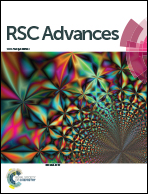Fabrication and photoactivity of short rod-shaped mesoporous SiO2@TiO2 composites with TiO2 shell†
Abstract
This paper presents an improved strategy for synthesizing short rod-shaped mesoporous SiO2@TiO2 composites containing a TiO2 shell by using short rod-shaped mesoporous SiO2–polyglycidyl methacrylate (PGMA)–polyoligo(ethylene glycol)methyl ether methacrylate (PEGMA) as a template and tetrabutyl titanate (TBT) as a titanium source. SiO2–PGMA-b-PEGMA rods were initially fabricated through grafting GMA and EGMA onto the surface of the halogen functional group of mesoporous SiO2 using activators regenerated by electron transfer-atom transfer radical polymerization. TBT was hydrolyzed with the PEGMA chain through hydrogen bonding. The rod-shaped mesoporous SiO2@TiO2 structure was finally acquired through calcination. Characterization results indicated that the amphiphilic block copolymer was grafted onto the mesoporous SiO2 surface. Moreover, the TiO2 samples existed only in the anatase phase, and the prepared SiO2@TiO2 exhibited bimodal nanoporous structures. The synthesized short rod-shaped mesoporous SiO2@TiO2 materials demonstrated higher specific surface area and absorption rate than samples prepared from non-mesoporous or unmodified rod-shaped SiO2. These characteristics effectively enhanced the photocatalytic activity of the composite. The photocatalytic activity of the fabricated composite was then tested on rhodamine B photodegradation.


 Please wait while we load your content...
Please wait while we load your content...